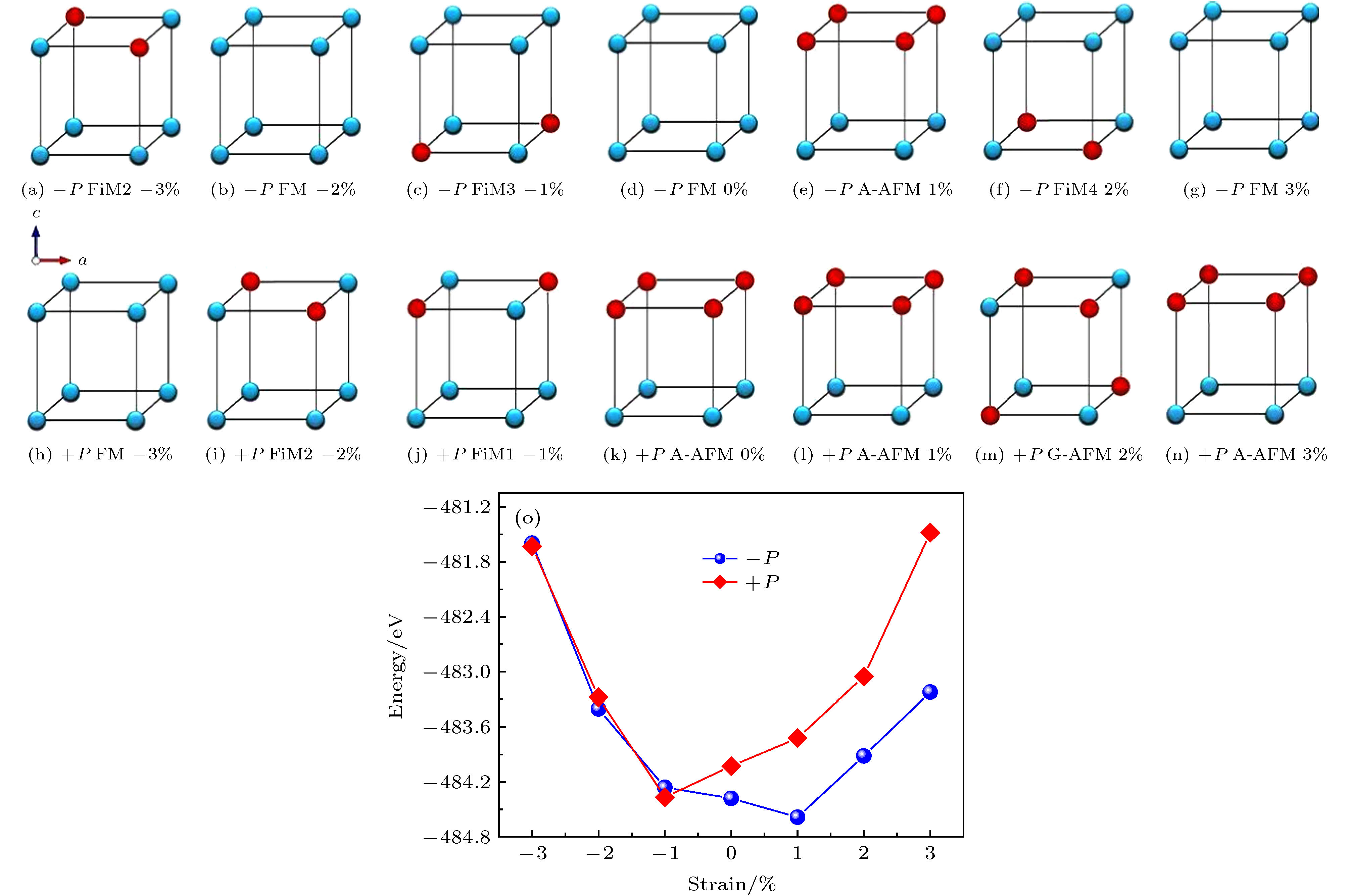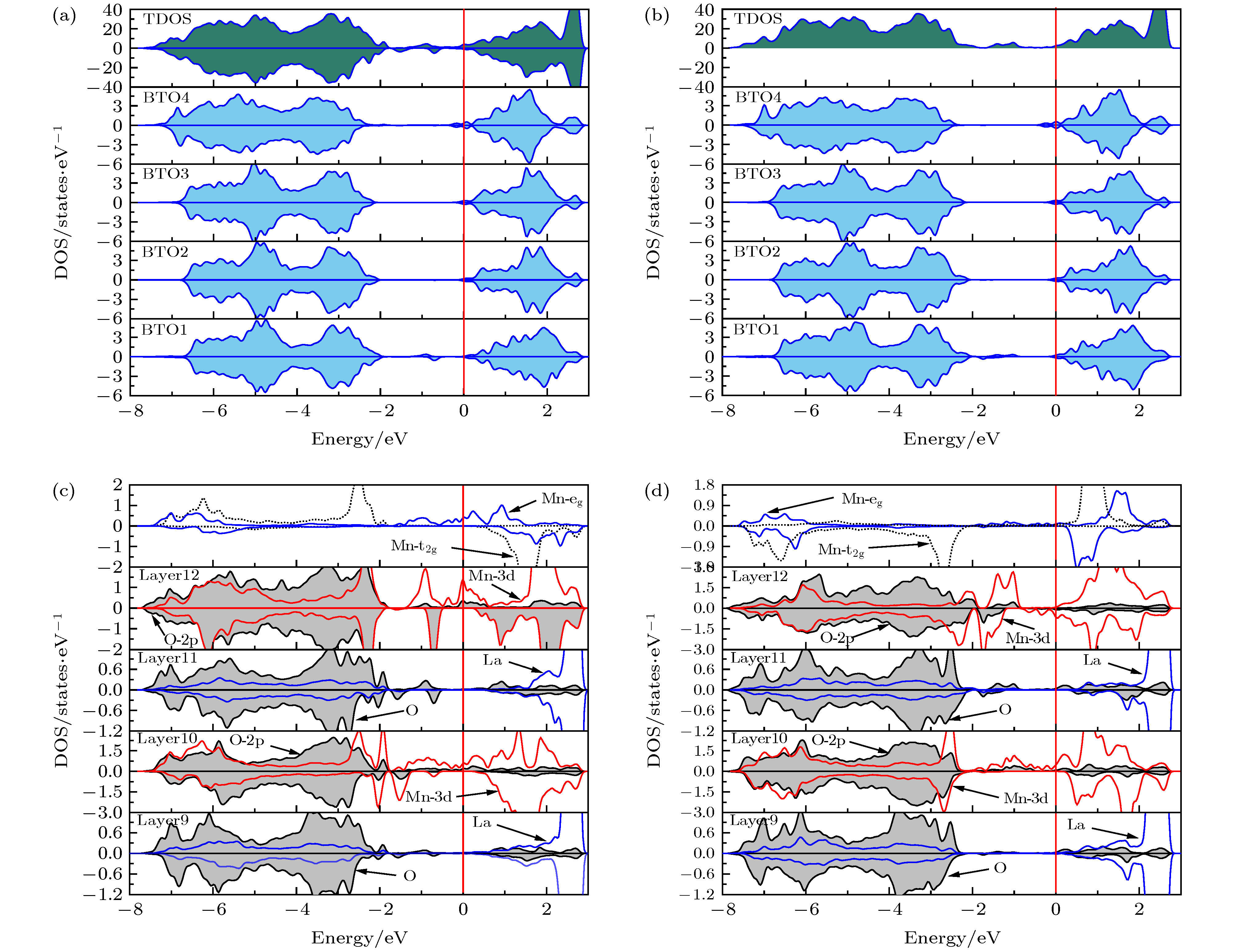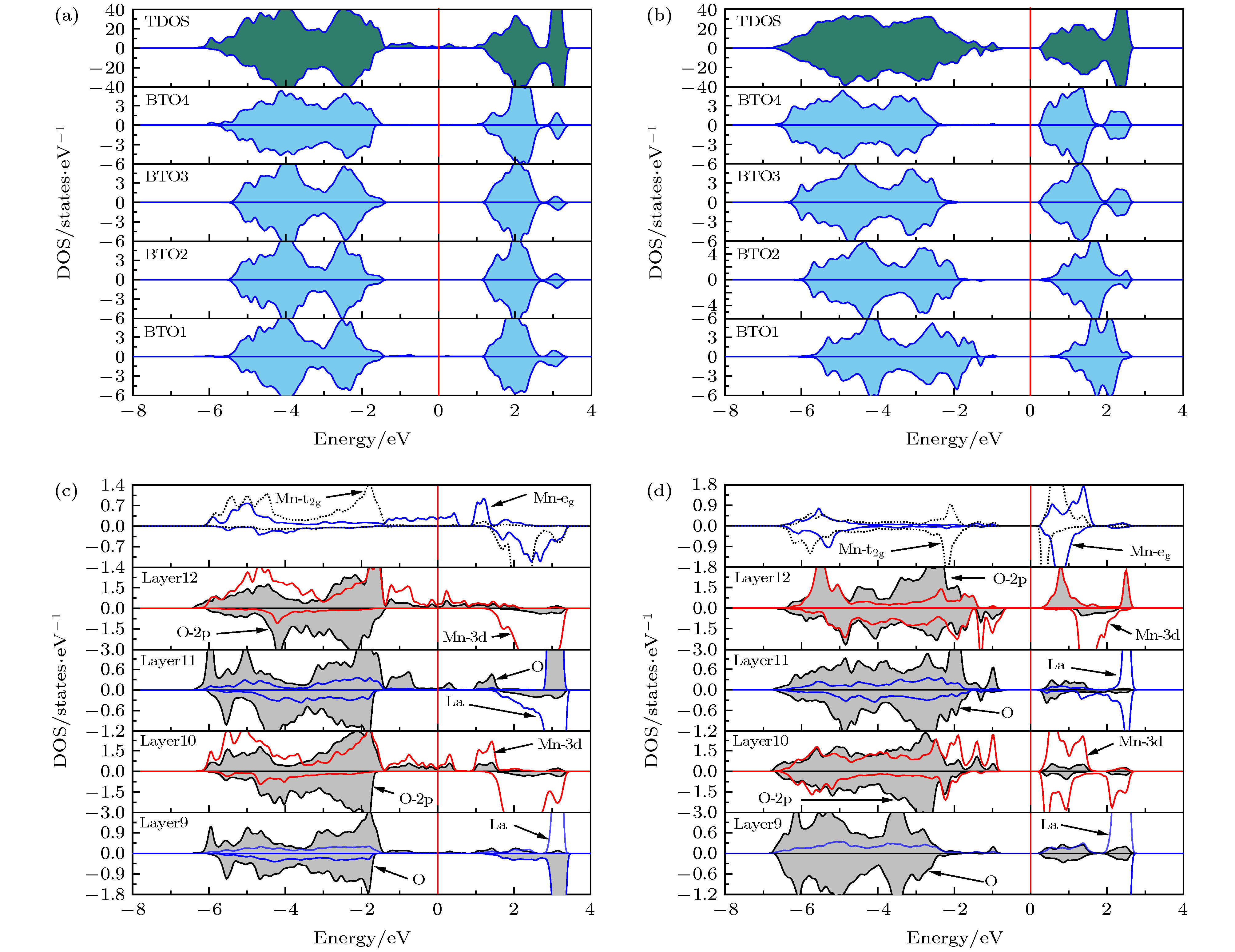-
对钙钛矿锰氧化物的磁性进行调控在科学上具有重要意义, 在自旋电子学领域更是有紧迫需求. 利用外延应变和铁电极化双重调控超晶格材料的磁性不但更加接近体系的真实状态, 而且能诱导出丰富的物理性质. 本文采用第一性原理计算, 系统地研究了外延应变和铁电极化对LaMnO3/BaTiO3超晶格磁性的鲁棒控制. 通过精确调控Mn原子磁矩的大小和方向, 实现了铁磁
$\leftrightarrow$ 反铁磁$\leftrightarrow$ 亚铁磁之间的可逆转变, 同时产生了强烈的磁电耦合效应. 除此之外, 本文在超晶格中实现了铁电极化和金属性共存. 通过分析Jahn-Teller效应, 氧八面体旋转、倾斜以及体系内部电子转移对磁性的影响, 揭示了磁性调控的物理机制. 研究结果不但对系统地了解LaMnO3体系的磁性变化具有重要意义, 而且可以为设计基于钙钛矿锰氧化物的自旋电子器件提供理论指导.The controlling of magnetism of perovskite oxides is scientifically interesting and technically important for numerous functionalities in spintronic devices and next-generation magnetic memories. The experimenally prepared superlattices often contain strain, polarization, oxygen vacancy and other factors, which can affect their magnetic properties. The magnetism of superlattice materials, controlled by using both epitaxial strain and ferroelectric polarization, is not only close to the real state of the material, but also can induce rich physical properties. In this work, we demonstrate a strong magnetoelectric coupling that appears in the LaMnO3/ BaTiO3 superlattice. First-principles calculations reveal that the reversible transitions among ferromagnetism, ferrimagnetism and anti-ferromagnetism are achieved by precisely controlling the magnitude and spin-direction of the magnetic moments of the Mn ions. A maximal change can be achieved to be 100.1% of the net magnetization by switching the ferroelectric polarization, which is much higher than the previous value 93.9%. The half-metallicity is demonstrated in the MnO2 layer, and accompanied by the spin polarization of the superlattice varying from 100% to 0. In addition, we realize the coexistence of ferroelectric polarization and metallicity, i.e. “ferroelectric metal”. Neither of the strong covalent Mn—O bond and La—O bond acts as an obstacle that prevents the ferroelectric polarization from penetrating the LMO layer. The Jahn-Teller effect, the tilt and rotation of oxygen octahedron, and the charge transfer of the superlattice are systemically analyzed. The variation of strain and re-orientation of polarization lead the electrons to transfer between the eg and t2g orbitals of Mn, which determines the magnetism of our system. Our purpose-designed LMO/BTO superlattice with robust intrinsic magnetoelectric coupling is a particularly interesting model system that can provide guidance for developing the spintronics for future applications.-
Keywords:
- first-principles /
- perovskite superlattice /
- electric control of magnetism /
- Interface effects
[1] Fiebig M, Lottermoser T, Meier D, Trassin M 2016 Nat. Rev. Mater. 1 16046
 Google Scholar
Google Scholar
[2] Dong S, Liu J M, Cheong S W, Ren Z F 2015 Adv. Phys. 64 519
 Google Scholar
Google Scholar
[3] 王春雷, 易晓磊, 姚超, 张谦君, 林鹤, 王栋梁, 马衍伟 2015 物理学报 64 117401
 Google Scholar
Google Scholar
Wang C L, Yi X L, Yao C, Zhang Q J, Lin H, Wang D L, Ma Y W 2015 Acta Phys. Sin. 64 117401
 Google Scholar
Google Scholar
[4] Yin H, Liu C, Zheng G P, Wang Y, Ren F 2019 Appl. Phys. Lett. 114 192903
 Google Scholar
Google Scholar
[5] Dong S, Yamauchi K, Yunoki S, et al. 2009 Phys. Rev. Lett. 103 127201
 Google Scholar
Google Scholar
[6] Zhou P X, Dong S, Liu H M, Ma C Y, Yan Z B, Zhong C G, Liu J M 2015 Sci. Rep. 5 13052
 Google Scholar
Google Scholar
[7] Feng M H, You S, Cheng N, Du J H 2019 Electrochim. Acta 293 356
 Google Scholar
Google Scholar
[8] Sun Z Z, Feng S, Gu C, Cheng N, Liu J 2019 Phys. Chem. Chem. Phys. 21 15206
 Google Scholar
Google Scholar
[9] Chen M, Zha R H, Yuan Z Y, et al. 2017 Chem. Eng. J. 313 791
 Google Scholar
Google Scholar
[10] 倪利红 2012 博士学位论文 (杭州: 浙江大学)
Ni L H 2012 Ph. D. Dissertation (Hangzhou: Zhejiang University) (in Chinese)
[11] Zhou Y J, Rabe K M 2013 Phys. Rev. B 88 094416
 Google Scholar
Google Scholar
[12] Zhong C, Lu X, Wan Y, Min Y, Zhao Z, Zhou P, Dong Z, Liu J 2018 J. Magn. Magn. Mater. 466 406
 Google Scholar
Google Scholar
[13] Renshaw Wang X, Li C J, et al. 2015 Science 349 716
 Google Scholar
Google Scholar
[14] Burton J D, Tsymbal E Y 2009 Phys. Rev. B 80 174406
 Google Scholar
Google Scholar
[15] Dong S, Dagotto E 2013 Phys. Rev. B 88 140404R
 Google Scholar
Google Scholar
[16] Cui B, Song C, Mao H, Wu H, Li F, Peng J, Wang G, Zeng F, Pan F 2015 Adv. Mater. 27 6651
 Google Scholar
Google Scholar
[17] Mishina E D, Buryakov A M, Sherstyuk N E, Sigov A S, Rasing T 2016 Ferroelectrics 500 37
 Google Scholar
Google Scholar
[18] Weng Y K, Huang X, Yao Y G, Dong S 2015 Phys. Rev. B 92 195114
 Google Scholar
Google Scholar
[19] Chen L Y, Chen C L, Jin K X, Wu T 2014 J. Appl. Phys. 116 074102
 Google Scholar
Google Scholar
[20] Lysogorskii Y V, Piyanzina I I, Lenotyev A V, et al. 2019 Ferroelectrics 541 74
 Google Scholar
Google Scholar
[21] Chen D, Zhang G B, Cheng Z X, Dong S, Wang Y X 2019 IUCrJ 6 189
 Google Scholar
Google Scholar
[22] Weng Y K, Lin L F, Dagotto E, Dong S 2016 Phys. Rev. Lett. 117 037601
 Google Scholar
Google Scholar
[23] Callori S J, Gabel J, Su D, Sinsheimer J, Fernandez-Serra M V, Dawber M 2012 Phys. Rev. Lett. 109 067601
 Google Scholar
Google Scholar
[24] Zhou P X, Liu H M, Yan Z B, Dong S, Liu J M 2014 J. Appl. Phys. 115 17D710
 Google Scholar
Google Scholar
[25] Wei L Y, Lian C, Meng S 2017 Phys. Rev. B 95 184102
 Google Scholar
Google Scholar
[26] Cheng X R, Shen M R 2007 Solid State Commun. 141 587
 Google Scholar
Google Scholar
[27] Zhang H M, Weng Y K, Yao Y X, Dong S 2015 Phys. Rev. B 91 195145
 Google Scholar
Google Scholar
[28] 赵润, 杨浩 2018 物理学报 67 156101
 Google Scholar
Google Scholar
Zhao R, Yang H 2018 Acta Phys. Sin. 67 156101
 Google Scholar
Google Scholar
[29] Sheng J M, Kan X C, Ge H, et al. 2020 Chin. Phys. B 29 057503
 Google Scholar
Google Scholar
[30] Perdew J P, Burke K, Ernzerhof M 1996 Phys. Rev. Lett. 77 3865
 Google Scholar
Google Scholar
[31] Liechtenstein A I, Anisimov V I, Zaanen J 1995 Phys. Rev. B 52 R5467
 Google Scholar
Google Scholar
[32] Lee J H, Delaney K T, Bousquet E, Spaldin N A, Rabe K M 2013 Phys. Rev. B 88 174426
 Google Scholar
Google Scholar
[33] Broyden C G 1969 AMS Notices 16 670
 Google Scholar
Google Scholar
[34] Ciucivara A, Sahu B, Kleinman L 2008 Phys. Rev. B 77 092407
 Google Scholar
Google Scholar
[35] Hashimoto T, Ishibashi S, Terakura K 2010 Phys. Rev. B 82 045124
 Google Scholar
Google Scholar
[36] Betancourt J, Paudel T R, Tsymbal E Y, Velev J P 2017 Phys. Rev. B 96 045113
 Google Scholar
Google Scholar
[37] He J, Borisevich A, Kalinin S V, Pennycook S J, Pantelides S T 2010 Phys. Rev. Lett. 105 227203
 Google Scholar
Google Scholar
[38] Sun W, Wang W X, Chen D, Cheng Z X, Wang Y X 2019 Nanoscale 11 9931
 Google Scholar
Google Scholar
[39] An M, Weng Y K, Zhang H M, Zhang J J, Zhang Y, Dong S 2017 Phys. Rev. B 96 235112
 Google Scholar
Google Scholar
[40] Aruta C, Adamo C, Galdi A, et al. 2009 Phys. Rev. B 80 140405R
 Google Scholar
Google Scholar
[41] Song G, Zhang W Y 2014 Sci. Rep. 4 4564
 Google Scholar
Google Scholar
[42] Liu C, Wang W H, Gong S, Zhang H B, Guo W 2017 Sci. Rep. 7 3856
 Google Scholar
Google Scholar
[43] Lee J, Sai N, Cai T, Niu Q, Demkov A A 2010 Phys. Rev. B 81 144425
 Google Scholar
Google Scholar
-
图 2 (a)−(n) LaMnO3/BaTiO3超晶格的磁序随着外延应变(–3%−3%)和极化方向的变化示意图 (蓝色代表自旋向上的Mn原子, 红色代表自旋向下的Mn原子); (o) 不同应变对应的最稳定结构的能量
Fig. 2. (a)−(n) Schematic diagram of the magnetic configuration variation with the epitaxial strain (–3%−3%) and the direction of ferroelectric polarization in the LaMnO3/BaTiO3 superlattices (The blue and red balls represent the spin-up and spin-down Mn atoms, respectively); (o) the total energies of the ground-state superlattices under different strains.
图 3 LaMnO3/BaTiO3超晶格的态密度: (a)–P极化和–3%外延应变时的总态密度和BaTiO3层的分层态密度; (b) +P极化和–3%外延应变时的总态密度和BaTiO3层的分层态密度; (c)–P极化和–3%外延应变以及(d) +P极化和–3%外延应变时的LaMnO3层的分层态密度和Mn原子的eg/t2g轨道的态密度
Fig. 3. The total density of states (TDOS) and layer-resolved DOS of the BaTiO3 part of the LaMnO3/BaTiO3 superlattice: (a) for the –P case with –3% epitaxial strain; (b) for the +P case with –3% strain. The Mn-eg/t2g DOS and the layer-resolved DOS of the LaMnO3 part (c) for the –P case with –3% epitaxial strain; (d) for the +P case with –3% strain.
图 4 LaMnO3/BaTiO3超晶格的态密度: (a) –P极化和3%外延应变时的总态密度和BaTiO3层的分层态密度; (b) +P极化和3%外延应变时的总态密度和BaTiO3层的分层态密度; (c) –P极化和3%外延应变以及(d) +P极化和3%外延应变时的LaMnO3层的分层态密度和Mn原子的eg/t2g轨道的态密度
Fig. 4. The total density of states (TDOS) and layer-resolved DOS of the BaTiO3 part of the LaMnO3/BaTiO3 superlattice: (a) for the –P case with 3% epitaxial strain; (b) for the +P case with 3% strain. The Mn-eg/t2 g DOS and the layer-resolved DOS of the LaMnO3 part (c) for the –P case with 3% strain; (d) for the +P case with 3% strain.
图 5 LaMnO3/BaTiO3超晶格在 (a) –P极化和–3%外延应变; (b) –P极化和3%外延应变; (c) +P极化和–3%外延应变和(d) +P极化和3%外延应变条件下的差分电荷密度图(等值面的数值为0.01 e/bohr3)
Fig. 5. Charge density difference of the LaMnO3/BaTiO3 superlattices for the (a) –P polarization and –3% epitaxial strain; (b) –P polarization and 3% strain; (c) +P polarization and –3% strain; and (d) +P polarization and 3% strain. The isosurface value is set to be 0.01 e/bohr3.
表 1 计算得到的LaMnO3/BaTiO3超晶格的基态性质: m1和m2 (μB)是Mn原子的平均磁矩, M (μB)是超晶格的净磁化强度, 导电性, LaMnO3层的Jahn-Teller畸变Q2, Q3(nm), 氧八面体倾斜角θ和旋转角φ
Table 1. The calculated ground-state properties of the LaMnO3/BaTiO3 superlattice at different strains: m1 and m2 (μB) are the local magnetic moment for the Mn atoms, M (μB) is the net magnetization, the conductivity, the Jahn-Teller distortions Q2, Q3 (nm), the octahedral tilt angle θ and rotation angle φ (degree) of the LaMnO3 layers.
应变 极化 磁序 m1 m2 M 导电性 θ1 θ2 φ1 φ2 Q2 Q3 — + FM 3.56 3.56 14.65 金属 5.7 6.6 4.4 5.3 0.0015 0.0259 — – FiM2 3.38 –3.76 6.41 金属 6.5 7.8 5.1 7.1 0.0017 0.0172 — + FiM2 3.41 –3.86 6.34 金属 7.2 8.2 4.5 6.9 0.0016 0.0198 — – FM 3.59 3.59 14.76 金属 7.5 8.7 5.3 7.8 0.0026 0.0199 — + FiM1 3.60 –3.72 6.78 金属 8.8 10.0 3.9 6.9 0.0019 0.0229 — – FiM3 3.55 –3.59 7.20 半金属 9.3 10.4 4.1 5.8 –0.0007 0.0347 0 + A-AFM 3.24 –3.55 — 金属 1.7 1.2 11.7 1.2 0.0010 0.0139 0 – FM 3.67 3.67 15.28 半金属 7.1 9.1 9.3 0.8 0.0047 0.0042 1% + A-AFM 3.66 –3.68 — 金属 9.3 9.9 7.5 6.4 0.0449 0.0272 1% – A-AFM 3.46 –3.92 — 半金属 11.5 12.4 4.4 8.0 0.0071 0.0286 2% + G-AFM 3.31 –3.95 — 绝缘体 11.9 11.1 6.1 7.0 0.0507 0.0165 2% – FiM4 -3.78 3.66 7.24 半金属 12.5 11.1 3.3 8.8 0.0013 0.0114 3% + A-AFM 3.71 –3.72 — 绝缘体 12.2 12.2 6.3 7.4 –1.0308 0.0967 3% – FM 3.75 3.75 15.17 半金属 13.7 13.3 5.0 8.9 0.0208 0.0324 表 2 不同外延应变和极化条件下LaMnO3/BaTiO3超晶格的Mn-3d轨道(含eg和t2g)的电子数
Table 2. Number of electrons for the Mn-3d orbitals (both eg and t2g) in the LaMnO3/BaTiO3 superlattice at different conditions.
应变 极化 磁序 eg轨道 t2g轨道 3d轨道 –3% –P FiM2 1.77 3.15 4.92 +P FM 1.68 3.26 4.94 0 –P FM 1.91 3.03 4.94 +P A-AFM 1.75 3.16 4.91 3% –P FM 1.80 3.02 4.81 +P A-AFM 1.60 3.26 4.87 -
[1] Fiebig M, Lottermoser T, Meier D, Trassin M 2016 Nat. Rev. Mater. 1 16046
 Google Scholar
Google Scholar
[2] Dong S, Liu J M, Cheong S W, Ren Z F 2015 Adv. Phys. 64 519
 Google Scholar
Google Scholar
[3] 王春雷, 易晓磊, 姚超, 张谦君, 林鹤, 王栋梁, 马衍伟 2015 物理学报 64 117401
 Google Scholar
Google Scholar
Wang C L, Yi X L, Yao C, Zhang Q J, Lin H, Wang D L, Ma Y W 2015 Acta Phys. Sin. 64 117401
 Google Scholar
Google Scholar
[4] Yin H, Liu C, Zheng G P, Wang Y, Ren F 2019 Appl. Phys. Lett. 114 192903
 Google Scholar
Google Scholar
[5] Dong S, Yamauchi K, Yunoki S, et al. 2009 Phys. Rev. Lett. 103 127201
 Google Scholar
Google Scholar
[6] Zhou P X, Dong S, Liu H M, Ma C Y, Yan Z B, Zhong C G, Liu J M 2015 Sci. Rep. 5 13052
 Google Scholar
Google Scholar
[7] Feng M H, You S, Cheng N, Du J H 2019 Electrochim. Acta 293 356
 Google Scholar
Google Scholar
[8] Sun Z Z, Feng S, Gu C, Cheng N, Liu J 2019 Phys. Chem. Chem. Phys. 21 15206
 Google Scholar
Google Scholar
[9] Chen M, Zha R H, Yuan Z Y, et al. 2017 Chem. Eng. J. 313 791
 Google Scholar
Google Scholar
[10] 倪利红 2012 博士学位论文 (杭州: 浙江大学)
Ni L H 2012 Ph. D. Dissertation (Hangzhou: Zhejiang University) (in Chinese)
[11] Zhou Y J, Rabe K M 2013 Phys. Rev. B 88 094416
 Google Scholar
Google Scholar
[12] Zhong C, Lu X, Wan Y, Min Y, Zhao Z, Zhou P, Dong Z, Liu J 2018 J. Magn. Magn. Mater. 466 406
 Google Scholar
Google Scholar
[13] Renshaw Wang X, Li C J, et al. 2015 Science 349 716
 Google Scholar
Google Scholar
[14] Burton J D, Tsymbal E Y 2009 Phys. Rev. B 80 174406
 Google Scholar
Google Scholar
[15] Dong S, Dagotto E 2013 Phys. Rev. B 88 140404R
 Google Scholar
Google Scholar
[16] Cui B, Song C, Mao H, Wu H, Li F, Peng J, Wang G, Zeng F, Pan F 2015 Adv. Mater. 27 6651
 Google Scholar
Google Scholar
[17] Mishina E D, Buryakov A M, Sherstyuk N E, Sigov A S, Rasing T 2016 Ferroelectrics 500 37
 Google Scholar
Google Scholar
[18] Weng Y K, Huang X, Yao Y G, Dong S 2015 Phys. Rev. B 92 195114
 Google Scholar
Google Scholar
[19] Chen L Y, Chen C L, Jin K X, Wu T 2014 J. Appl. Phys. 116 074102
 Google Scholar
Google Scholar
[20] Lysogorskii Y V, Piyanzina I I, Lenotyev A V, et al. 2019 Ferroelectrics 541 74
 Google Scholar
Google Scholar
[21] Chen D, Zhang G B, Cheng Z X, Dong S, Wang Y X 2019 IUCrJ 6 189
 Google Scholar
Google Scholar
[22] Weng Y K, Lin L F, Dagotto E, Dong S 2016 Phys. Rev. Lett. 117 037601
 Google Scholar
Google Scholar
[23] Callori S J, Gabel J, Su D, Sinsheimer J, Fernandez-Serra M V, Dawber M 2012 Phys. Rev. Lett. 109 067601
 Google Scholar
Google Scholar
[24] Zhou P X, Liu H M, Yan Z B, Dong S, Liu J M 2014 J. Appl. Phys. 115 17D710
 Google Scholar
Google Scholar
[25] Wei L Y, Lian C, Meng S 2017 Phys. Rev. B 95 184102
 Google Scholar
Google Scholar
[26] Cheng X R, Shen M R 2007 Solid State Commun. 141 587
 Google Scholar
Google Scholar
[27] Zhang H M, Weng Y K, Yao Y X, Dong S 2015 Phys. Rev. B 91 195145
 Google Scholar
Google Scholar
[28] 赵润, 杨浩 2018 物理学报 67 156101
 Google Scholar
Google Scholar
Zhao R, Yang H 2018 Acta Phys. Sin. 67 156101
 Google Scholar
Google Scholar
[29] Sheng J M, Kan X C, Ge H, et al. 2020 Chin. Phys. B 29 057503
 Google Scholar
Google Scholar
[30] Perdew J P, Burke K, Ernzerhof M 1996 Phys. Rev. Lett. 77 3865
 Google Scholar
Google Scholar
[31] Liechtenstein A I, Anisimov V I, Zaanen J 1995 Phys. Rev. B 52 R5467
 Google Scholar
Google Scholar
[32] Lee J H, Delaney K T, Bousquet E, Spaldin N A, Rabe K M 2013 Phys. Rev. B 88 174426
 Google Scholar
Google Scholar
[33] Broyden C G 1969 AMS Notices 16 670
 Google Scholar
Google Scholar
[34] Ciucivara A, Sahu B, Kleinman L 2008 Phys. Rev. B 77 092407
 Google Scholar
Google Scholar
[35] Hashimoto T, Ishibashi S, Terakura K 2010 Phys. Rev. B 82 045124
 Google Scholar
Google Scholar
[36] Betancourt J, Paudel T R, Tsymbal E Y, Velev J P 2017 Phys. Rev. B 96 045113
 Google Scholar
Google Scholar
[37] He J, Borisevich A, Kalinin S V, Pennycook S J, Pantelides S T 2010 Phys. Rev. Lett. 105 227203
 Google Scholar
Google Scholar
[38] Sun W, Wang W X, Chen D, Cheng Z X, Wang Y X 2019 Nanoscale 11 9931
 Google Scholar
Google Scholar
[39] An M, Weng Y K, Zhang H M, Zhang J J, Zhang Y, Dong S 2017 Phys. Rev. B 96 235112
 Google Scholar
Google Scholar
[40] Aruta C, Adamo C, Galdi A, et al. 2009 Phys. Rev. B 80 140405R
 Google Scholar
Google Scholar
[41] Song G, Zhang W Y 2014 Sci. Rep. 4 4564
 Google Scholar
Google Scholar
[42] Liu C, Wang W H, Gong S, Zhang H B, Guo W 2017 Sci. Rep. 7 3856
 Google Scholar
Google Scholar
[43] Lee J, Sai N, Cai T, Niu Q, Demkov A A 2010 Phys. Rev. B 81 144425
 Google Scholar
Google Scholar
计量
- 文章访问数: 9475
- PDF下载量: 170
- 被引次数: 0















 下载:
下载:




